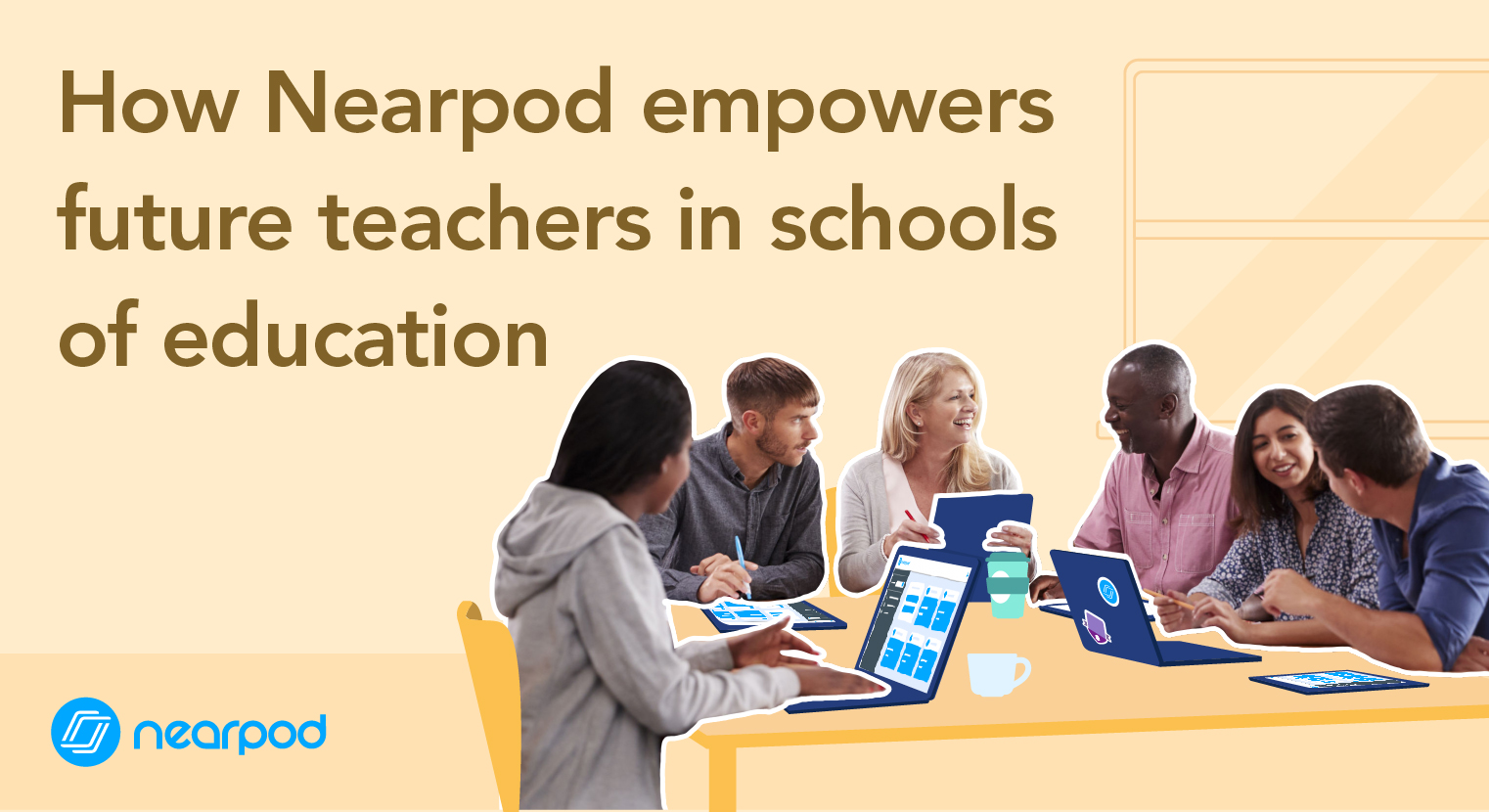
How Nearpod empowers future teachers in schools of education
If you ask teachers about the technology training they received as a preservice teacher, many will likely point to a single education technology course they took during their undergraduate education program.
While the format and content of these courses vary enormously across the US, one strategy that can be useful is modeling beneficial approaches to technology integration. This way, preservice teachers can experience first-hand how technology can be used in their future classrooms to help improve student learning.
Regardless of the structure of these types of courses, odds are, the instructor will need to deliver content, collect feedback, and share resources. Based on these needs, Nearpod can be an excellent tool for both teaching and modeling.
Use Nearpod to deliver instruction and gather feedback data
Nearpod lessons allow teachers to add in a wide variety of content, formative assessment activities, and online resources. Nearpod can handle it all; from website links andYouTube videos, to virtual reality field trips ; which allow instructors to combine and curate a diverse collection of lessons and resources to share with their preservice teachers.
With Nearpod, instructors can easily make their lessons more engaging with Nearpod’s interactive activities, while also gathering formative assessment data to guide further instruction or adjust teaching on the fly. Instructors can pose open-ended discussion questions, send out quizzes, polls, ask students to collaborate on a question or problem, or do any of Nearpod’s 12+ interactive assessments ; while gathering real-time student feedback.Associate professor Dr. Anne Leftwich of Indiana University explains how her Nearpod lessons benefit from these types of activities:
“What I love most about Nearpod are the interactive activities. These activities force me to think about my lesson and to think about which parts of my lesson can be broken up to give our preservice teachers an opportunity to talk, to discuss, and to collaborate. I particularly love the drawn response feature, and the Collaborate! feature is just awesome.”
Instructors can also use Nearpod to instantly collect formative assessment feedback from their preservice teachers. Assistant professor Jayme Linton describes how Nearpod is an excellent tool for both teaching and assessing, all without losing a beat:
“Master teachers don’t stop teaching to assess, and stop assessing to teach. Nearpod [lets teachers] seamlessly assess student learning and then use student responses to immediately adjust instruction.”
Dr. Diana Rogers-Adkinson, Dean of the College of Education for Southeast Missouri State University, expands on this idea by discussing how preservice teachers at her university benefit from Nearpod during their first teaching experiences:
“When our preservice teachers are out in the field, they appreciate that they can get just-in-time-feedback. While they’re teaching, they know if they need to reteach or redo a part of the lesson, because they can see if students didn’t master what they just taught. We find this to be really beneficial for our first time teachers.”
By allowing instructors to send out polls, start collaboration boards, and ask open-ended questions, Nearpod can provide instant formative assessment feedback on how students are doing with the content at hand. This powerful instructional delivery combination has proven successful for instructors of future educators, as well as current practicing educators in the classroom.
Create a learning environment driven by student feedback data
Nearpod can also be useful in providing transparency in the instructional process. When a course instructor receives formative assessment feedback from their preservice teachers in a Nearpod lesson, they can discuss with their students specifically how they are using that formative assessment data or feedback to make changes to instruction.
By making this process transparent and opening it up to discussion, instructors can model how this type of feedback could be useful in the classroom. Bette Schneiderman and Mike Byrne, who are the Co-Directors of LIU Post’s Educational Technology Program, discuss with their graduate students how data collected through Nearpod’s formative assessments can be used in the classroom:
“Data collection with Nearpod offers extraordinary opportunities to link action and data for evidence with engagement. We address with our graduate students that data is now being collected everywhere and seemingly on everything (e.g., cars moving through traffic/red lights, purchases online, GPS locations searched, and just about everything able to be collected digitally). We can spend our time and energy looking at useless data or we can create data collection systems that give us the information we find of value. Nearpod lets us do that. We are the designers. We must know what we seek and then create our questions to capture reactions and evidence of learning to the triggers we offer our students. Refining our ability to do that is a skill we think important.”
Instructors can also model the wide variety of interactive features that Nearpod offers. As Laurie Guyon describes, this type of modeling can help spark ideas for how Nearpod can be beneficial for K-12 students:
“[Preservice teachers are] able to see the great ways Nearpod interactive features can encourage engagement and communication of ideas, and then they [get] to jump in by using Collaborate! to share authentically on ways they [feel] Nearpod could be used with students in their future classrooms.”
By modeling these types of practices, preservice teachers can gain a better understanding of the types of instructional approaches they can use in their future classroom.
Make learning active with Nearpod
The US Department of Education suggests that a major focus of preservice teacher education programs should be on “the active use of technology to enable learning and teaching through creation, production, and problem-solving.” Nearpod can be a useful tool for having students create their own lessons and resource collections, making a profound impact on teaching and learning.
When preservice teachers create their own interactive lessons through Nearpod and then deliver those lessons to their peers; this kind of preparation activity can benefit preservice teachers so they experience how things might go in their future classroom.
Nearpod not only offers a way to combine and deliver a variety of digital content; the platform provides instructional power to create interactive and engaging lessons that are perfect for educators and students at all levels..Ready to give Nearpod a try?

Nearpod’s award-winning platform is used by thousands of schools around the globe, transforming classroom engagement.



